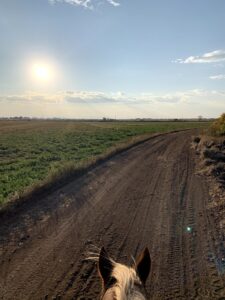by Haley Ruffner
28 December 2022 | [email protected] | 307.205.6628
My dad, who was roped into horses and farming when he married my mom, would say this to me every summer in the hayfield—me on the wagon, him tossing bales up to me, both dripping sweat and commiserating about the 90-degree day, hay crusted to our forearms and down our shirt collars. “We gotta make hay while the sun shines.”
This is true, of course, in humid Western New York, where sometimes we don’t get a first cutting in until July if we’re having a particularly wet year. 2021 was one such year, in which we didn’t have three dry days in a row until summer was halfway over. Even as a child, I picked up the habit of checking the sky for clouds after we’d cut hay, willing Mother Nature to not ruin my horses’ winter feed.
Stacking bales in the hay loft on what felt like the hottest day of the year was the highlight of my summer. I was proud of the new blisters on my hands and comforted in the sight and smell of fresh hay up to the barn rafters. My sense of responsibility for a crop so susceptible to nature’s whims instilled a farmer’s mentality in me from the time I was big enough to lift a bale—I marked my summers by the cycles of rainfall and wind, of dry sunny days and early-morning fog that burned off the hayfields by midday.
Back home in New York, haying was a family activity. The day we baled hay, all of our family and friends would come over to put it up and have a potluck dinner—having 20 or 30 people involved gave it a holiday feel despite the intensity of physical labor involved in moving 1,000 two-string bales from the field to the wagon to stacked 25 feet high in the hay loft.
When I left the green rolling hills of Western New York to explore the Colorado mountains, I encountered a growing season opposite from everything I knew. Here, the lack of rainfall necessitated irrigation, and most farmers cut and baled at night to avoid excess dryness and poor leaf retention—they make hay when the sun doesn’t shine. I spent my summer working a 91-acre flood irrigated hay farm (the modern offspring of traditional acequia irrigation) for a family friend who was ill.
The field was split by dikes that held the water (more or less) in lanes with a 12” pipe running alongside it and gates in the pipe to let the water flow. Crumbling dikes and countless prairie dog holes required me to walk the lanes with water on them twice daily with my shovel, patching falling dirt walls and filling prairie dog holes that sucked the water right back down into the earth.
My routine that summer went as follows: drive my uncle’s old diesel truck along dirt roads to the farm in the shadow of Mount Blanca, check the oil level in the well pump, then walk the rows I had water in. If the water had made it to the end of the row (a process that sometimes took several days as the field hadn’t been graded in years), I could open the next gates down to move water to the next few rows. I walked the fields in the morning before work, sometimes on my lunch break, and in the evenings. Towards the end of the first month when first cutting was nearly ready, I wore through the shovel I’d been using—snapped it clean off at the base of the handle. Instead of the blisters I got back home from a hard day’s work, I grew thick calluses along my palms from sustained shoveling.
When the hay was ready—grass showing heads but not yet gone to seed, alfalfa starting to bud but not yet blooming its purple flowers—I learned how to use the massive old swather to cut the field. With only one machine, I did this job alone, spending hours in its dusty cab mowing the 91 acres I walked so many times. On the floor of the San Luis Valley ringed by mountains, not a single cloud loomed on the horizon, nor had I seen one in days. It was still too early for summer monsoon season, and the windy days ensured the hay would dry quickly.
Whereas at home we often had to rake our hay and let it sit for days to dry enough to bale, out West the concern was baling it fast enough to retain moisture. We baled mostly 3×4 square bales, and everything was moved with a skidsteer with forks on it—gone was the human element of several sets of hands on each bale to get it moved, pared down to a few people with large machinery.
That phrase from my childhood that always makes me picture my dad with a beer in hand and hay in his mustache— “Make hay while the sun shines”—doesn’t hold the same weight in the harsh beauty of the West. Nature always rules, and we have to make hay around its schedule.

_______
Haley Ruffner is a Sales Broker for Aden Brook and an accomplished writer on the topic of horses.
